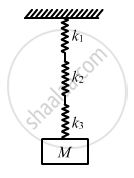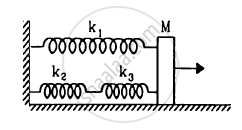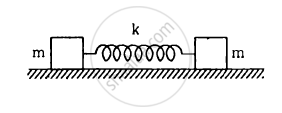Advertisements
Advertisements
प्रश्न
Find the elastic potential energy stored in each spring shown in figure, when the block is in equilibrium. Also find the time period of vertical oscillation of the block.
उत्तर

All three spring attached to the mass M are in series.
k1, k2, k3 are the spring constants.
Let k be the resultant spring constant.
\[\frac{1}{k} = \frac{1}{k_1} + \frac{1}{k_2} + \frac{1}{k_3}\]
\[ \Rightarrow k = \frac{k_1 k_2 k_3}{k_1 k_2 + k_2 k_3 + k_3 k_1}\]
\[\text { Time period }\left( T \right)\text{ is given by, }\]
\[T = 2\pi\sqrt{\frac{M}{k}}\]
\[ = 2\sqrt{\frac{M\left( k_1 k_2 + k_2 k_3 + k_3 k_1 \right)}{k_1 k_2 k_3}}\]
\[ = 2\sqrt{M\left( \frac{1}{k_1} + \frac{1}{k_2} + \frac{1}{k_3} \right)}\]
As force is equal to the weight of the body,
F = weight = Mg
Let x1, x2, and x3 be the displacements of the springs having spring constants k1, k2 andk3 respectively.
For spring k1,
\[x_1 = \frac{Mg}{k_1}\]
\[\text { Similarly }, x_2 = \frac{Mg}{k_2}\]
\[\text { and } x_3 = \frac{Mg}{k_3}\]
\[ \therefore {PE}_1 = \frac{1}{2} k_1 x_1^2 \]
\[ = \frac{1}{2} k_1 \left( \frac{Mg}{k_1} \right)^2 \]
\[ = \frac{1}{2} k_1 \frac{M^2 g^2}{k_1^2}\]
\[ = \frac{1}{2}\frac{M^2 g^2}{k_1} = \frac{M^2 g^2}{2 k_1}\]
\[\text { Similarly }, {PE}_2 = \frac{M^2 g^2}{2 k_2}\]
\[\text { and } {PE}_3 = \frac{M^2 g^2}{2 k_3}\]
Notes
The Figure is missing in Question .
APPEARS IN
संबंधित प्रश्न
A particle having mass 10 g oscillates according to the equation x = (2.0 cm) sin [(100 s−1)t + π/6]. Find (a) the amplitude, the time period and the spring constant. (c) the position, the velocity and the acceleration at t = 0.
The pendulum of a clock is replaced by a spring-mass system with the spring having spring constant 0.1 N/m. What mass should be attached to the spring?
A block suspended from a vertical spring is in equilibrium. Show that the extension of the spring equals the length of an equivalent simple pendulum, i.e., a pendulum having frequency same as that of the block.
The block of mass m1 shown in figure is fastened to the spring and the block of mass m2 is placed against it. (a) Find the compression of the spring in the equilibrium position. (b) The blocks are pushed a further distance (2/k) (m1 + m2)g sin θ against the spring and released. Find the position where the two blocks separate. (c) What is the common speed of blocks at the time of separation?

The springs shown in the figure are all unstretched in the beginning when a man starts pulling the block. The man exerts a constant force F on the block. Find the amplitude and the frequency of the motion of the block.

Solve the previous problem if the pulley has a moment of inertia I about its axis and the string does not slip over it.
Consider the situation shown in figure . Show that if the blocks are displaced slightly in opposite direction and released, they will execute simple harmonic motion. Calculate the time period.

A rectangle plate of sides a and b is suspended from a ceiling by two parallel string of length L each in Figure . The separation between the string is d. The plate is displaced slightly in its plane keeping the strings tight. Show that it will execute simple harmonic motion. Find the time period.

Discuss in detail the energy in simple harmonic motion.
Show that for a particle executing simple harmonic motion.
- the average value of kinetic energy is equal to the average value of potential energy.
- average potential energy = average kinetic energy = `1/2` (total energy)
Hint: average kinetic energy = <kinetic energy> = `1/"T" int_0^"T" ("Kinetic energy") "dt"` and
average potential energy = <potential energy> = `1/"T" int_0^"T" ("Potential energy") "dt"`
Motion of an oscillating liquid column in a U-tube is ______.
Displacement versus time curve for a particle executing S.H.M. is shown in figure. Identify the points marked at which (i) velocity of the oscillator is zero, (ii) speed of the oscillator is maximum.

Find the displacement of a simple harmonic oscillator at which its P.E. is half of the maximum energy of the oscillator.
A particle undergoing simple harmonic motion has time dependent displacement given by x(t) = A sin`(pit)/90`. The ratio of kinetic to the potential energy of this particle at t = 210s will be ______.
